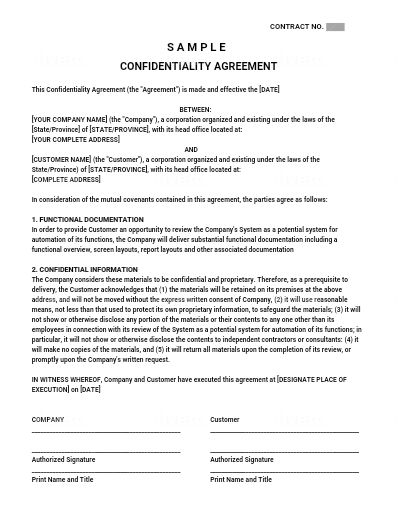Part 1. Introduction
A confidentiality agreement also termed a non-disclosure agreement, is a legally enforceable contract between two or more parties that outlines secret information, knowledge, or stuff that the parties want to convey for specific purposes but still want to limit from being disclosed to other people.
- Nonetheless, when corporations are contemplating a potential business alliance confidentiality agreements are frequently used. These agreements make it possible for companies to share trade secrets and intellectual property with selected partners to understand whether continuing relations would be mutually useful.

Protecting Sensitive Information
- A well-drafted template for confidentiality agreements is an essential tool in the protection of sensitive information. Lack of one exposes businesses to risks such as theft and leakage of trade secrets which could lead to destruction of competitive advantage as well as tarnish the reputation and have serious financial implications.
Key Components
- Thus, a comprehensive confidentiality agreement should mention the identified parties; describe what will be treated confidential; how that information can be used/not used; consequences for violation. Moreover, there should be a timeframe for which it remains valid and a provision for extending its validity if necessary.
Ensuring Compliance
- When people have signed this confidential agreement, they must do something so that it is upheld. Among them are training employees on how to take care of sensitive data and who has the authority over what type of information, limiting access as well as monitoring compliance regularly. In case a breach occurs, the injured party should act fast enough to curb it and minimize damage.
Part 2. Confidentiality Agreement Template Overview
What is a Confidentiality Agreement?
- A confidentiality agreement also referred to as a non-disclosure agreement or NDA is a legally binding contract that establishes that a confidential relationship exists between the parties. It outlines their obligations and duties to protect each other’s private information.
Key Components of a Confidentiality Agreement
- The first very important part would be defining what constitutes “confidential information”. This may involve trade secrets, intellectual property, customer lists, and financial records among others. The agreement needs to specifically identify what qualifies as such in detail.
- The obligations and responsibilities segment entails what can be done with the confidential information of each party involved. Normally the recipient agrees not to reveal or enable any outsiders to learn about it. Similarly, they could agree not to make use of this for personal gains.
- The consequences for breaching the agreement should be clearly stated. This could include financial penalties, loss of access to information, or termination of the business relationship. The agreement should also specify how long the confidentiality obligations will last and the process for returning or destroying confidential information.
Part 3. Free Confidentiality Agreement Template
If you’re looking to create a confidentiality agreement, you’re in luck. There are many free templates available online that can save you time and money. Using a template is convenient since the format and general terms are already laid out for you. All you have to do is customize the details to suit your particular needs.
Cost-Effective Solution
- Free confidentiality agreement templates are ideal if you’re on a budget. You don’t have to pay expensive legal fees to draft an agreement from scratch. The template provides the framework, you simply fill in the blanks with specifics relevant to your situation. For many small businesses or individuals, a free template is a perfectly suitable option.
Customize As Needed
- While free templates provide a good starting point, you want to make sure the final agreement reflects the particulars of your relationship or project. Carefully review each section and clause in the template and modify anything that doesn’t apply or needs to be tailored to your needs. You may need to add or remove certain provisions or specify key details like the parties involved, the purpose of sharing confidential information, how long the agreement lasts, and what constitutes a breach of confidentiality.
Consider Consulting an Attorney
- An attorney might help review your own personalized confidentiality agreement template if the agreements or the situations are complex. In case of any weak provisions or clauses that need strengthening, they can advise on the same. Nevertheless, legal counsel is always helpful in high-risk and high-stakes agreements even if they are not a requirement.
Part 4. NDA Confidentiality Agreement Template
A confidentiality agreement also known as a non-disclosure agreement(NDA) is a contract that legally binds and establishes confidential relationships between two parties. Whereas a generic confidentiality agreement only forbids the release of proprietary information, an NDA specifically bars the disclosure of trade secrets.
What Should Be Included in an NDA Confidentiality Agreement?
To make it valid, an effective NDA should identify which information is confidential and state this clearly. Further stipulations should include how long this agreement will last and what happens once it is breached by either party.
Some key clauses to include in an NDA confidentiality agreement are:
- A broad definition of “confidential information” includes trade secrets, proprietary information, and anything marked as confidential.
- An obligation for the receiving party to protect the confidential information using a reasonable standard of care. This includes safeguarding physical documents as well as digital files.
- A restriction on the use of confidential information solely to evaluate or engage in a business relationship. The receiving party cannot use it for other reasons.
- A non-disclosure provision prohibiting the receiving party from disclosing confidential information to any third parties without prior written consent.
- A breach of contract clause specifies penalties if the agreement is breached, such as monetary damages or termination of the business relationship.
- A return of information paragraph compels the recipient to give back the private details or destroy them once the contract is over.
- Some NDAs will also specify a period during which certain information must remain confidential even after termination. It could take years before an NDA expires, normally 2-5 years.
Why Is an NDA Important?
An NDA allows companies to be able to share their secrets with others like investors, partners, and employees without fear that they may be exposed to the public. This enhances free speech within an organization and builds trust. If there was no NDA in place, firms would not freely discuss their competitive advantages such as new product designs, marketing plans, and other material properties.
For this reason, whenever confidential information needs to be shared between two or more parties, an NDA should always be thought about. With it comes better business partnerships; collaborations as well as sponsors just to mention a few examples.
Part 5. Employee Confidentiality Agreement Template
To protect your company’s sensitive information, trade secrets, and intellectual property, you must have your employees sign confidentiality agreements. Employees must acknowledge their obligation not to disclose any confidential company matters either during or following their employment through a well-drafted confidential agreement.
Key Provisions to Include
- The agreement should specify that employees must not share trade secrets, proprietary information, or client details with third parties. It should also prohibit them from using such information for their benefit or soliciting company clients after leaving the organization.
Non-Disclosure of Trade Secrets
- Do not disclose or share proprietary technologies, business methods, and other intellectual property with unauthorized persons. This also refers to the information in digital, physical, or verbal forms. Employees should comprehend that sharing trade secrets or IP can erode their competitive advantage and sabotage business prosperity.
Non-Solicitation of Clients
- This should include an agreement prohibiting employees from soliciting company clients for a given period once they leave the firm. For instance, deny them access to shareholders between 12-24 months as this can lead to the loss of key accounts to rival traders. You must describe various kinds of solicitation encompassing such activities as calling upon, communicating with, or selling to clients.
Ensure Employee Compliance
- There should be training sessions held to ensure that employees are aware of what confidentiality agreements entail. Their understanding can be backed by signing statements. If there are any violations take place, disciplinary actions like dismissal must be taken against those who violated it. In addition, this documentation has to be reviewed periodically for it to reflect changes brought about by legislation and new standards related to commercial practices and security procedures.
An effective confidentiality agreement, paired with proper employee education and enforcement, will help safeguard your company’s most valuable information and intellectual assets. Protecting trade secrets and client relationships is key to maintaining a competitive advantage and long-term success. With the right agreement in place, you can build a culture where privacy and security become second nature.
Part 6. Conclusion
If your mind has not been changed about this, keep in mind the importance of a privacy agreement for the protection of sensitive information and intellectual property. Whether you are disclosing trade secrets to a business partner, hiring new staff, or dealing with freelancers, an NDA should be put into place.
While creating a confidentiality agreement from scratch may seem overwhelming, using a free template is one of the simplest ways to get going. Then personalize the specifics to fit your unique circumstance. Make sure to define what is confidential and what can and cannot be done with it as well as the consequences for breaking such an agreement.
Before sharing any confidential information with them, don’t forget that it’s good practice to have your newly employed personnel or contractors sign the last version of the agreement.
Protect Yourself and Your Business
- Prevention is better than cure. A few minutes spent on implementing an NDA will ensure that your trade secrets do not end up in the wrong hands however, nothing will substitute for diligent employee screening. Regardless of whether one is just starting his own company or is already heading an existing firm, confidentiality remains crucial for sustaining competitive advantage.
- While it may be tempting to forgo this process when working with people you trust, it’s important to remain vigilant. Require an NDA for any business relationship where sensitive information will be shared, no matter how much you value the other party. Your hard work and ideas are worth safeguarding.

